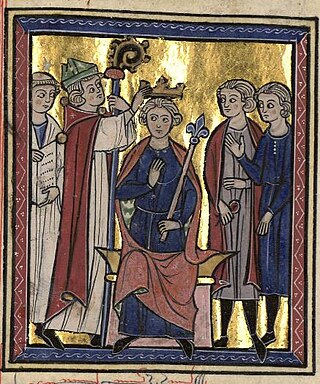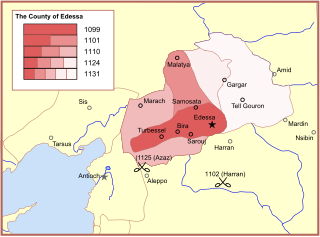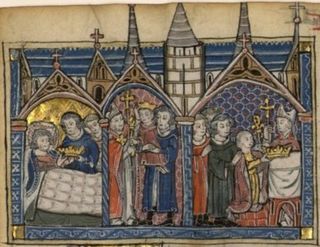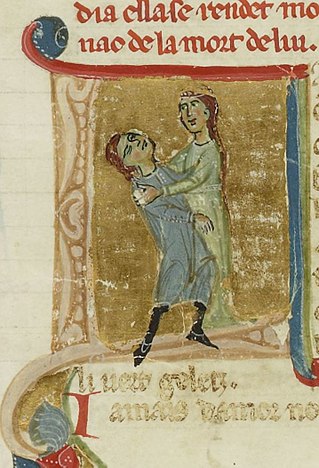
Melisende was Queen of Jerusalem from 1131 to 1153, and regent for her son between 1153 and 1161, while he was on campaign. She was the eldest daughter of King Baldwin II of Jerusalem, and the Armenian princess Morphia of Melitene.

Bohemond II was Prince of Taranto from 1111 to 1128 and Prince of Antioch from 1111/1119 to 1130. He was the son of Bohemond I, who in 1108 was forced to submit to the authority of the Byzantine Empire in the Treaty of Devol. Three years later, the infant Bohemond inherited the Principality of Taranto under the guardianship of his mother, Constance of France. The Principality of Antioch was administered by his father's nephew, Tancred, until 1111. Tancred's cousin, Roger of Salerno, managed the principality from 1111 to 1119. After Roger died in the Battle of the Field of Blood, Baldwin II of Jerusalem took over the administration of Antioch. However, he did acknowledge Bohemond's right to personally rule the principality upon reaching the age of majority.

Fulk, also known as Fulk the Younger, was the count of Anjou from 1109 to 1129 and the king of Jerusalem with his wife Melisende from 1131 to his death. During their reign, the Kingdom of Jerusalem reached its largest territorial extent.

Baldwin II, also known as Baldwin of Bourcq or Bourg, was Count of Edessa from 1100 to 1118, and King of Jerusalem from 1118 until his death. He accompanied his cousins Godfrey of Bouillon and Baldwin of Boulogne to the Holy Land during the First Crusade. He succeeded Baldwin of Boulogne as the second count of Edessa when he left the county for Jerusalem following his brother's death. He was captured at the Battle of Harran in 1104. He was held first by Sökmen of Mardin, then by Jikirmish of Mosul, and finally by Jawali Saqawa. During his captivity, Tancred, the Crusader ruler of the Principality of Antioch, and Tancred's cousin, Richard of Salerno, governed Edessa as Baldwin's regents.

The County of Edessa was a 12th-century Crusader state in Upper Mesopotamia. Its seat was the city of Edessa.

The Principality of Antioch was one of the Crusader states created during the First Crusade which included parts of modern-day Turkey and Syria. The principality was much smaller than the County of Edessa or the Kingdom of Jerusalem. It extended around the northeastern edge of the Mediterranean, bordering the County of Tripoli to the south, Edessa to the east, and the Byzantine Empire or the Kingdom of Armenia to the northwest, depending on the date.
Joscelin I was a Frankish nobleman of the House of Courtenay who ruled as the lord of Turbessel, prince of Galilee (1112–1119) and count of Edessa (1118–1131). The County of Edessa reached its zenith during his rule. Captured twice, Joscelin continued to expand his county, even participating in the Battle of Azaz in 1125. Gravely injured during the collapse of a sapper mine, Joscelin marched his army to relieve the besieged fortress of Kaysun, and died soon after.

Raymond III was count of Tripoli from 1152 to 1187. He was a minor when Nizari Assassins murdered his father, Raymond II of Tripoli. Baldwin III of Jerusalem, who was staying in Tripoli, made Raymond's mother, Hodierna of Jerusalem, regent. Raymond spent the following years at the royal court in Jerusalem. He reached the age of majority in 1155, after which he participated in a series of military campaigns against Nur ad-Din, the Zengid ruler of Damascus. In 1161 he hired pirates to pillage the Byzantine coastline and islands to take vengeance on Byzantine emperor Manuel I Komnenos, who had refused to marry his sister Melisende. He was captured in the Battle of Harim by Nur ad-Din's troops on 10 August 1164, and imprisoned in Aleppo for almost ten years. During his captivity, Amalric I of Jerusalem administered the county of Tripoli on his behalf.

Sibylla was the queen of Jerusalem from 1186 to 1190. She reigned alongside her husband Guy of Lusignan, to whom she was unwaveringly attached despite his unpopularity among the barons of the Kingdom of Jerusalem.

Joscelin II was the fourth and last ruling count of Edessa. He was son of his predecessor, Joscelin I, and Beatrice, daughter of Constantine I of Armenia.
Constance of Hauteville (1128–1163) was the ruling princess of Antioch from 1130 to 1163. She was the only child of Bohemond II of Antioch and Alice of Jerusalem. Constance succeeded her father at the age of two after he fell in battle, although his cousin Roger II of Sicily laid claim to Antioch. Alice assumed the regency, but the Antiochene noblemen replaced her with her father, Baldwin II of Jerusalem. After he died in 1131, Alice again tried to take control of the government, but the Antiochene barons acknowledged the right of her brother-in-law Fulk of Anjou to rule as regent for Constance.

Agnes of Courtenay was a Frankish noblewoman who held considerable influence in the Kingdom of Jerusalem during the reign of her son, King Baldwin IV. Though she was never queen, she has been described as the most powerful woman in the kingdom's history after Queen Melisende.

Hodierna of Jerusalem was a countess consort of Tripoli through her marriage to Raymond II of Tripoli, and regent of the County of Tripoli during the minority of her son from 1152 until 1155.
Alice of Jerusalem was a Princess consort of Antioch by marriage to Bohemond II of Antioch. She engaged in a longlasting power struggle during the reign of her daughter Constance of Antioch.
Ioveta was a Latin princess from the crusader Kingdom of Jerusalem. Her name appears in various other forms, including Joveta, Yveta, Yvette, Ivetta, and Juditta. She headed the Convent of Saint Lazarus in Bethany, the richest abbey in the kingdom, from the late 1130s or early 1140s until her death.

The siege of Edessa took place from 28 November to 24 December 1144, resulting in the fall of the capital of the County of Edessa to Zengi, the atabeg of Mosul and Aleppo. This event was the catalyst for the Second Crusade.
Gabriel of Melitene was an Armenian general who ruled the city of Melitene. Gabriel started his career as an officer of the Byzantine general Philaretos Brachamios, who installed him in Melitene. After the general's death, Gabriel broke away from the Byzantine Empire. He sought to ally himself with the leaders of the crusades and had his daughter, Morphia, marry Baldwin II of Edessa. He was killed after Melitene was conquered by the Seljuk Turks.
William of Bures was Prince of Galilee from 1119 or 1120 to his death. He was descended from a French noble family which held estates near Paris. William and his brother, Godfrey, were listed among the chief vassals of Joscelin of Courtenay, Prince of Galilee, when their presence in the Holy Land was first recorded in 1115. After Joscelin received the County of Edessa from Baldwin II of Jerusalem in 1119, the king granted the Principality of Galilee to William. He succeeded Eustace Grenier as constable and bailiff in 1123. In his latter capacity, he administered the kingdom during the Baldwin II's captivity for more than a year, but his authority was limited.

Thoros was an Armenian ruler of Edessa at the time of the First Crusade. Thoros was a former officer (curopalates) in the Byzantine Empire and a lieutenant of Philaretos Brachamios. He was Armenian but practiced the Greek Orthodox faith.
Hugh I, Count of Rethel was a son of Count Manasses III of Rethel and his wife Judith. He succeeded his father in 1065 as Count of Rethel.















